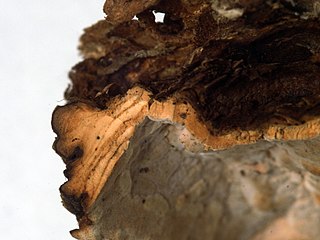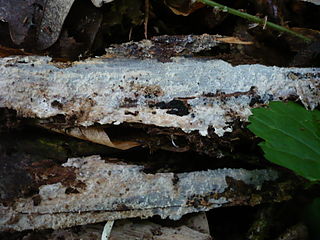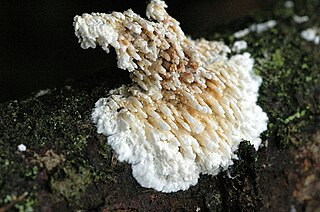
The Hymenochaetales are an order of fungi in the class Agaricomycetes. The order in its current sense is based on molecular research and not on any unifying morphological characteristics. According to one 2008 estimate, the Hymenochaetales contain around 600 species worldwide, mostly corticioid fungi and poroid fungi, but also including several clavarioid fungi and agarics. Species of economic importance include wood decay fungi in the genera Phellinus and Inonotus sensu lato, some of which may cause losses in forestry. Therapeutic properties are claimed for Inonotus obliquus ("chaga") and Phellinus linteus, both of which are now commercially marketed.

Phanerochaete is a genus of crust fungi in the family Phanerochaetaceae.

The Meruliaceae are a family of fungi in the order Polyporales. According to a 2008 estimate, the family contains 47 genera and 420 species. As of April 2018, Index Fungorum accepts 645 species in the family.

The Phanerochaetaceae are a family of mostly crust fungi in the order Polyporales.

The Xenasmataceae are a family of crust fungi in the order Polyporales. The family was circumscribed in 1966 by German mycologist Franz Oberwinkler with Xenasma as the type genus. As of April 2018, Index Fungorum accepts 28 species in the family. Xenasmataceae fungi grow as saprobes on fallen wood and are known primarily from temperate areas.

Laurilia is a monotypic genus of crust fungi in the family Echinodontiaceae. The genus was described in 1959 by Czech mycologist Zdeněk Pouzar, with Laurilia sulcata as the type and only species. Pouzar then transferred Laurilia taxodii from Stereum to Laurilia in 1968, but Liu et al. erected the new genus Laurillela for the latter species in 2017 on the basis of ribosomal DNA molecular phylogeny. Liu et al. also found the Echinodontiaceae as traditionally circumscribed to be paraphyletic and placed Laurilia and Lauriliella instead in the Bondarzewiaceae, though this placement is not yet reflected in taxonomic authorities such as the Index Fungorum.

Byssomerulius is a widely distributed genus of crust fungi.
Candelabrochaete is a genus of crust fungi in the family Phanerochaetaceae.

Resinicium is a genus of crust fungi of uncertain placement in the class Agaricomycetes. The genus was circumscribed by Estonian mycologist Erast Parmasto in 1968.

Phlebia is a genus of mostly crust fungi in the family Meruliaceae. The genus has a widespread distribution. Phlebia species cause white rot.

Mycoacia is a genus of toothed crust fungi in the family Meruliaceae. It was circumscribed by Dutch mycologist Marinus Anton Donk in 1931.

Dacryobolus is a genus of crust fungi in the family Fomitopsidaceae. Elias Fries circumscribed the genus in 1849 with Dacryobolus sudans as the type species. Dacryobolus are wood-decay fungi that cause a brown rot.
Gloeohypochnicium is a genus of wood-inhabiting crust fungi of uncertain familial placement in the order Russulales. Originally conceived by Erast Parmasto as a subgenus of Hypochnicium, Kurt Hjortstam considered it worthy of distinct generic status in 1987. The type species, G. analogum, was described as new to science in 1913 by French mycologists Hubert Bourdot and Amédée Galzin as a species of Gloeocystidium. G. versatum was added to the genus in 2010.

Hydnophlebia is a genus of five species of toothed crust fungi in the family Meruliaceae. All species are wood-decay fungi that cause a white rot.

Hyphoderma is a genus of crust fungi in the family Meruliaceae. It was circumscribed by German botanist Karl Friedrich Wilhelm Wallroth in 1833.

Steccherinum is a widely distributed genus of toothed crust fungi in the family Steccherinaceae.

Dentocorticium is a genus of six species of poroid fungi in the family Polyporaceae. The genus was revised in 2018, with several new species added and some older species transferred to other genera, based on phylogenetic analyses.

Hyphodontia is a genus of fungi in the family Hymenochaetaceae. The genus was circumscribed by Swedish mycologist John Eriksson in 1958.

Xylodon is a genus of crust fungi in the family Schizoporaceae.
Phlebiella is a genus of crust fungi in the order Polyporales.
















